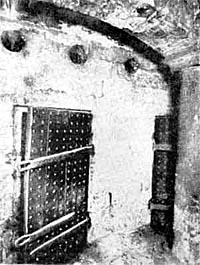< Previous | Contents | Next >
Shire Hall dungeons, Nottingham
 |
SURELY the Nottingham Shire Hall on the High Pavement, Nottingham, is one of the strangest buildings in England for, although it is in the centre of the city it is part and parcel of the county, forming the smallest civil parish in England.
The reason for this strange state of affairs is that the site has been used almost from time immemorial as a prison for the counties of Nottingham and Derby, and when, in 1448, Henry VI. made Nottingham into a County Corporate, be expressly excepted this house and left it under the old jurisdiction.
The mediaeval premises got into more and more disrepair as time passed, and at last, in 1724, most of the building fell down very nearly involving a judge in the disaster After much argument it was decided to erect a new Shire Hall and as property adjoining the old building had come into the hands of the authorities, a much larger site than the old restricted area was available for the new building which was completed in 1771 – just before the War of American Independence.
The old dividing line between town and county still remains, and wanders about the building in a most amusing and confusing manner.
There are many relics of its age-long use as a prison to be found in the Shire Hall. At the back are the remains of exercise yards, day wards and dormitories of a prison in full use in 1833, and which might have served as a model for Mr. Pickwick’s adventures equally as well as the Fleet prison.
Below these remains are certain caverns which look like primitive prisons, and may well have been so used. Hidden away amidst a mass of almost inexplicable substructures are two gruesome chambers, dark and ill-ventilated, which are pictured here. They began life as sleeping quarters for poor prisoners, but in their latter end were used as condemned cells in the clays when stealing a silk pocket handkerchief was a hanging matter.
